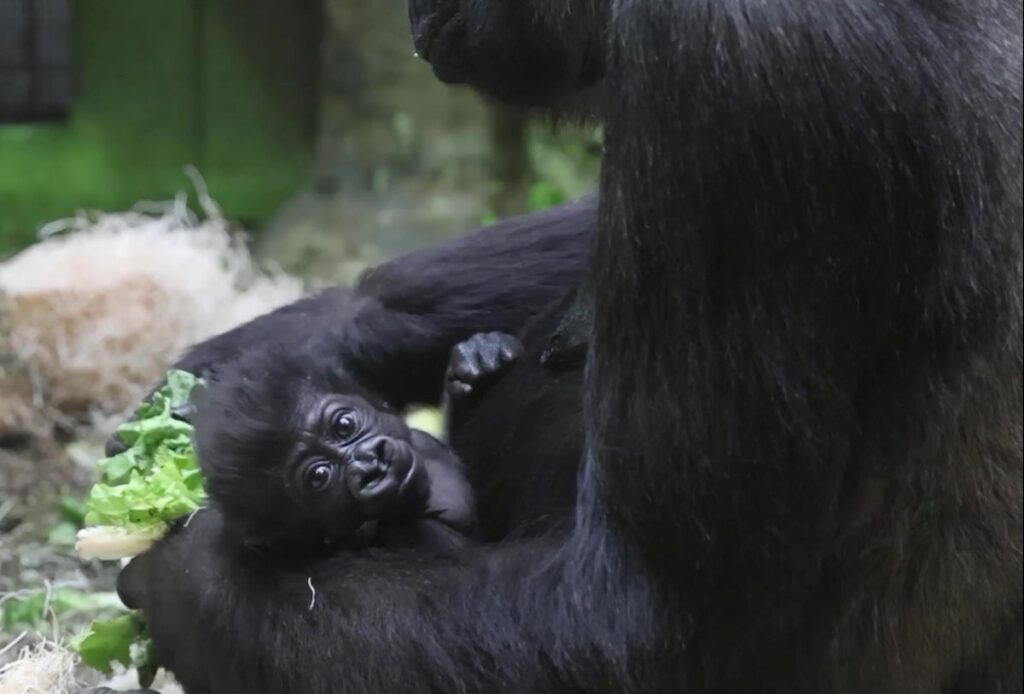From Fragile Beginnings to a Family’s Embrace.586
In late October, a fragile miracle arrived. At just under three pounds, a tiny western lowland gorilla was born—the first in the zoo’s 139-year history. He was quickly given a nickname, Baby G, and from the moment he entered the world, all eyes were on him.
His start in life was delicate. Newborn gorillas, like human infants, depend on constant care—warmth, touch, and nourishment. But Baby G’s young mother, new to the overwhelming role of motherhood, struggled to manage the needs of her tiny son. In the wild, this could have been the end. But within the troop, something extraordinary happened.
The eldest female, Fredrika, quietly stepped in. With the wisdom of her years, she cradled Baby G against her chest, wrapping her strong arms around him as though he had been her own from the beginning. The instinct to nurture was immediate, and her presence became his lifeline.

For weeks, Baby G thrived under Fredrika’s steady care. Visitors and staff alike marveled at the sight: a wise elder carrying the zoo’s tiniest treasure, holding him with a gentleness that seemed to transcend words. Each day, Baby G grew a little stronger, a little more curious, his wide eyes watching the world from the safety of her embrace.
But life, as it often does, threw another challenge.
Baby G fell ill. Pneumonia threatened his fragile body, and zookeepers were faced with a heart-wrenching decision: separate him from his troop to provide the intensive care he desperately needed. It was a risk—not only medically, but socially. Gorillas are deeply bonded creatures, and separations can sometimes mean permanent rejection.

Still, there was no choice. Baby G was taken behind the scenes, surrounded not by his family but by the hum of medical equipment and the watchful eyes of veterinarians. Day after day, staff worked tirelessly to keep him alive. And slowly, miraculously, he began to recover. His tiny chest grew stronger, his breathing steadier. The baby who had entered the world so small and uncertain doubled his weight.
Yet as his health improved, another question loomed: Would his family accept him back?
The day of the reunion arrived with both hope and fear. Staff gathered, silent and anxious, as Baby G was reintroduced to his troop. Would they recognize him? Would they welcome him? Or would they turn away?
The first to approach was Fredrika. She moved forward slowly, her wise eyes scanning the tiny gorilla placed before her. For a moment, the world seemed to hold its breath. Then, with a soft sniff, she reached out, scooped Baby G into her arms, and pressed him against her chest as though she had never let him go.

It was a breathtaking moment. His father, Mokolo, stood nearby, watching with a protective gaze. The rest of the troop gathered close, calm and accepting, as if they, too, understood the significance of what had just taken place. Against every odd, Baby G was home again.
For those who witnessed it, the reunion was more than just a milestone in the zoo’s history. It was a living testament to the resilience of family, to the instincts of care that cross generations and species, and to the fragile yet powerful thread of survival that ties us all together.
Today, Baby G is thriving. He spends his days clinging to Fredrika’s back, tumbling awkwardly in play, and exploring the world with the wide-eyed wonder of a child who has already survived more than most. Visitors line the glass, captivated not only by his small frame but by the enormous story he carries with him—a story of loss, love, and second chances.
For the zoo, Baby G is a symbol of hope for his critically endangered species. For his troop, he is family. And for those who hear his story, he is a reminder that sometimes, the smallest lives carry the greatest lessons: that love can heal, that family is chosen as much as it is born, and that survival is not just about strength, but about being held when you are at your weakest.
✨ From near tragedy to a heartwarming reunion, Baby G’s journey is one the world won’t soon forget.





